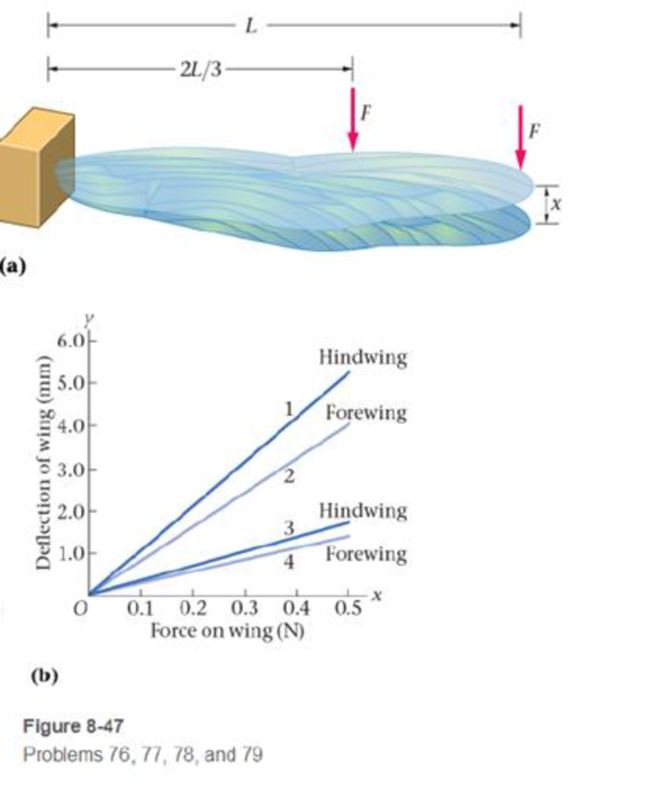
BIO The Flight of the Dragonflies
Of all the animals you’re likely to see on a summer day, the most ancient is the dragonfly. In fact, the fossil record for dragonflies extends back over 250 million years, more than twice as long as for birds. Ancient dragonflies could be as large as a hawk, and were surely buzzing around the heads of both T. Rex and Triceratops.
Dragonflies belong to the order Odonata (“toothed jaws”) and the suborder Anisoptera (“different wings”), a reference to the fact that their hindwings are wider front-to-back than their forewings. (Damselflies. in contrast, have forewings and hindwings that are the same width ) Although ancient in their lineage, dragonflies are among the fastest flying and most acrobatic of all insects; some of their maneuvers subject them to accelerations as great as 20g.
The properties of dragonfly wings, and how they account for such speed and mobility, have been of great interest to biologists Figure 8-47 (a) shows an experimental setup designed to measure the force constant of Plexiglas models of wings, which are used in wind tunnel tests A downward force is applied to the model wing at the tip (1 for hindwing, 2 for forewing) or at two-thirds the distance to the tip (3 for hindwing, 4 for forewing). As the force is varied in magnitude, the resulting deflection of the wing is measured The results are shown in Figure 8-47 (b) Notice that significant differences are seen between the hindwings and forewings, as one might expect from their different shapes.

76. • Treating the model wing as an ideal spring what is the force constant of the hindwing when a force is applied to its tip?
- A. 94 N/m
- B. 130 N/m
- C. 290 N/m
- D. 330 N/m
Want to see the full answer?
Check out a sample textbook solution
Chapter 8 Solutions
Physics, Books a la Carte Edition (5th Edition)
Additional Science Textbook Solutions
Microbiology with Diseases by Body System (5th Edition)
Human Physiology: An Integrated Approach (8th Edition)
Concepts of Genetics (12th Edition)
Physics for Scientists and Engineers: A Strategic Approach, Vol. 1 (Chs 1-21) (4th Edition)
Campbell Biology (11th Edition)
Organic Chemistry (8th Edition)
- RT = 4.7E-30 18V IT = 2.3E-3A+ 12 38Ω ли 56Ω ли r5 27Ω ли r3 28Ω r4 > 75Ω r6 600 0.343V 75.8A Now figure out how much current in going through the r4 resistor. |4 = unit And then use that current to find the voltage drop across the r resistor. V4 = unitarrow_forward7 Find the volume inside the cone z² = x²+y², above the (x, y) plane, and between the spheres x²+y²+z² = 1 and x² + y²+z² = 4. Hint: use spherical polar coordinates.arrow_forwardганм Two long, straight wires are oriented perpendicular to the page, as shown in the figure(Figure 1). The current in one wire is I₁ = 3.0 A, pointing into the page, and the current in the other wire is 12 4.0 A, pointing out of the page. = Find the magnitude and direction of the net magnetic field at point P. Express your answer using two significant figures. VO ΜΕ ΑΣΦ ? Figure P 5.0 cm 5.0 cm ₁ = 3.0 A 12 = 4.0 A B: μΤ You have already submitted this answer. Enter a new answer. No credit lost. Try again. Submit Previous Answers Request Answer 1 of 1 Part B X Express your answer using two significant figures. ΜΕ ΑΣΦ 0 = 0 ? below the dashed line to the right P You have already submitted this answer. Enter a new answer. No credit lost. Try again.arrow_forward
 College PhysicsPhysicsISBN:9781285737027Author:Raymond A. Serway, Chris VuillePublisher:Cengage Learning
College PhysicsPhysicsISBN:9781285737027Author:Raymond A. Serway, Chris VuillePublisher:Cengage Learning Physics for Scientists and EngineersPhysicsISBN:9781337553278Author:Raymond A. Serway, John W. JewettPublisher:Cengage Learning
Physics for Scientists and EngineersPhysicsISBN:9781337553278Author:Raymond A. Serway, John W. JewettPublisher:Cengage Learning Physics for Scientists and Engineers with Modern ...PhysicsISBN:9781337553292Author:Raymond A. Serway, John W. JewettPublisher:Cengage Learning
Physics for Scientists and Engineers with Modern ...PhysicsISBN:9781337553292Author:Raymond A. Serway, John W. JewettPublisher:Cengage Learning Physics for Scientists and Engineers: Foundations...PhysicsISBN:9781133939146Author:Katz, Debora M.Publisher:Cengage Learning
Physics for Scientists and Engineers: Foundations...PhysicsISBN:9781133939146Author:Katz, Debora M.Publisher:Cengage Learning College PhysicsPhysicsISBN:9781938168000Author:Paul Peter Urone, Roger HinrichsPublisher:OpenStax College
College PhysicsPhysicsISBN:9781938168000Author:Paul Peter Urone, Roger HinrichsPublisher:OpenStax College University Physics Volume 1PhysicsISBN:9781938168277Author:William Moebs, Samuel J. Ling, Jeff SannyPublisher:OpenStax - Rice University
University Physics Volume 1PhysicsISBN:9781938168277Author:William Moebs, Samuel J. Ling, Jeff SannyPublisher:OpenStax - Rice University





